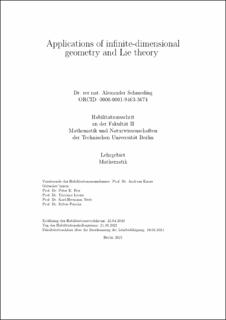Applications of infinite-dimensional geometry and Lie theory
Others
Published version
Permanent lenke
https://hdl.handle.net/11250/2775418Utgivelsesdato
2021Metadata
Vis full innførselSamlinger
Originalversjon
Schmeding, A. (2021). Applications of infinite-dimensional geometry and Lie theory (habilitation thesis). Technische Universität Berlin.Sammendrag
Infinite-dimensional manifolds and Lie groups arise from problems related to differential geometry, fluid dynamics, and the symmetry of evolution equations. Among the most prominent examples of infinite-dimensional manifolds are manifolds of (differentiable) mappings and the diffeomorphism groups Diff(K), where K is a smooth and compact manifold. The group Diff(K) is an infinite-dimensional Lie group which arises naturally in fluid dynamics if K is a three-dimensional torus. The motion of a particle in the fluid corresponds, under periodic boundary conditions, to a curve in Diff(K). As a working definition, an infinite-dimensional Lie group will be a group which at the same time is an infinite-dimensional manifold that turns the group operations into smooth mappings. An infinite-dimensional manifold will be a topological space which is locally (in charts) homeomorphic to an open subset of an infinite-dimensional space. Moreover, we require the change of charts to be smooth. Beyond the realm of Banach spaces, the usual concept of smoothness is no longer available and we replace it with the requirement that all directional derivatives exist and induce continuous mappings, the so called Bastiani calculus. Infinite-dimensional Lie groups and their homogeneous spaces will be the objects of our main interest. In conjunction with Lie theory, we exploit tools from (infinite-dimensional) Riemannian geometry. Recall that a Riemannian metric on a manifold is a choice of inner product for every tangent space which ”depends smoothly” on the basepoint. Generalising Riemannian geometry to infinite-dimensional manifolds, one faces in general the problem that there are no (smooth) partitions of unity. Further, the inner products will in general not be compatible with the topology of the tangent spaces as they are not Hilbert spaces. Thus the finite-dimensional definition of a Riemannian metric (what we will call a ’strong Riemannian metric’) has to be relaxed to admit relevant examples beyond the Hilbert manifold setting. This leads to the notion of a ’weak Riemannian metric’, i.e. a smooth choice of inner products on each tangent space which do not necessarily induce the topology of the tangent space. Constructing weak Riemannian metrics on manifolds of mappings from the L2-inner product, the resulting metrics are studied for example in shape analysis, fluid dynamics and optimal transport. The present thesis explores structures from infinite-dimensional Lie theory and Riemannian geometry, their interplay and applications in three main topics: - Connections between infinite-dimensional Lie groups and higher geometry, - Hopf algebra character groups as Lie groups, and - Applications of the interplay between Lie theory and Riemannian geometry.
Beskrivelse
Består av
Paper I: Schmeding, A. (2019). The Lie group of vertical biscetions of a regular Lie groupoid. Forum Mathematicum, 32(2), 479-489. doi: 10.1515/forum-2019-0128Paper II: Schmeding, A. & Wockel, C. (2016). (Re)constructing Lie groupoids from their bisections and applications to prequantisation. Differential Geometry and its Applications, 49, 227-276. doi: 10.1016/j.difgeo.2016.07.009
Paper III: Amiri, H. & Schmeding, A. (2019). Linking Lie groupoid representations and representations of infinite-dimensional Lie groups. Annals of Global Analysis and Geometry, 55, 749-775. doi: 10.1007/s10455-019-09650-3
Paper IV: Bogfjellmo, G. & Schmeding, A. (2017). The Lie group structure of the Butcher group. Foundations of Computational Mathematics, 17, 127-159. doi: 10.1007/s10208-015-9285-5
Paper V: Bogfjellmo, G., Dahmen, R. & Schmeding, A. (2016). Character group of Hopf algebras as infinite-dimensional Lie groups. Annales de l'institut Fourier, 66(5), 2101-2155. doi: 10.5802/aif.3059
Paper VI: Curry, C. & Schmeding, A. (2020). Convergence of Lie group integrators. Numerische Mathematik, 144, 357-373. doi: 10.1007/s00211-019-01083-1
Paper VII: Celledoni, E., Eidnes, S. & Schmeding, A. (2018). Shape analysis on homogeneous spaces: A generalised SRVT framework. In: Celledoni, E., di Nunno, G., Ebrahimi-Fard, K. & Munthe-Kaas, H. (Eds.). Computation and combinatorics in dynamics, stochastics and control. Abelsymposium 2016. Abel Symposia, 13. Springer. doi: 10.1007/978-3-030-01593-0_7
Paper VIII: Maurelli, M., Modin, K. & Schmeding, A. (forthcoming). Incompressible Euler equations with stochastic forcing: a geometric approach. Preprint available on arXiv: 1909.09982v3
